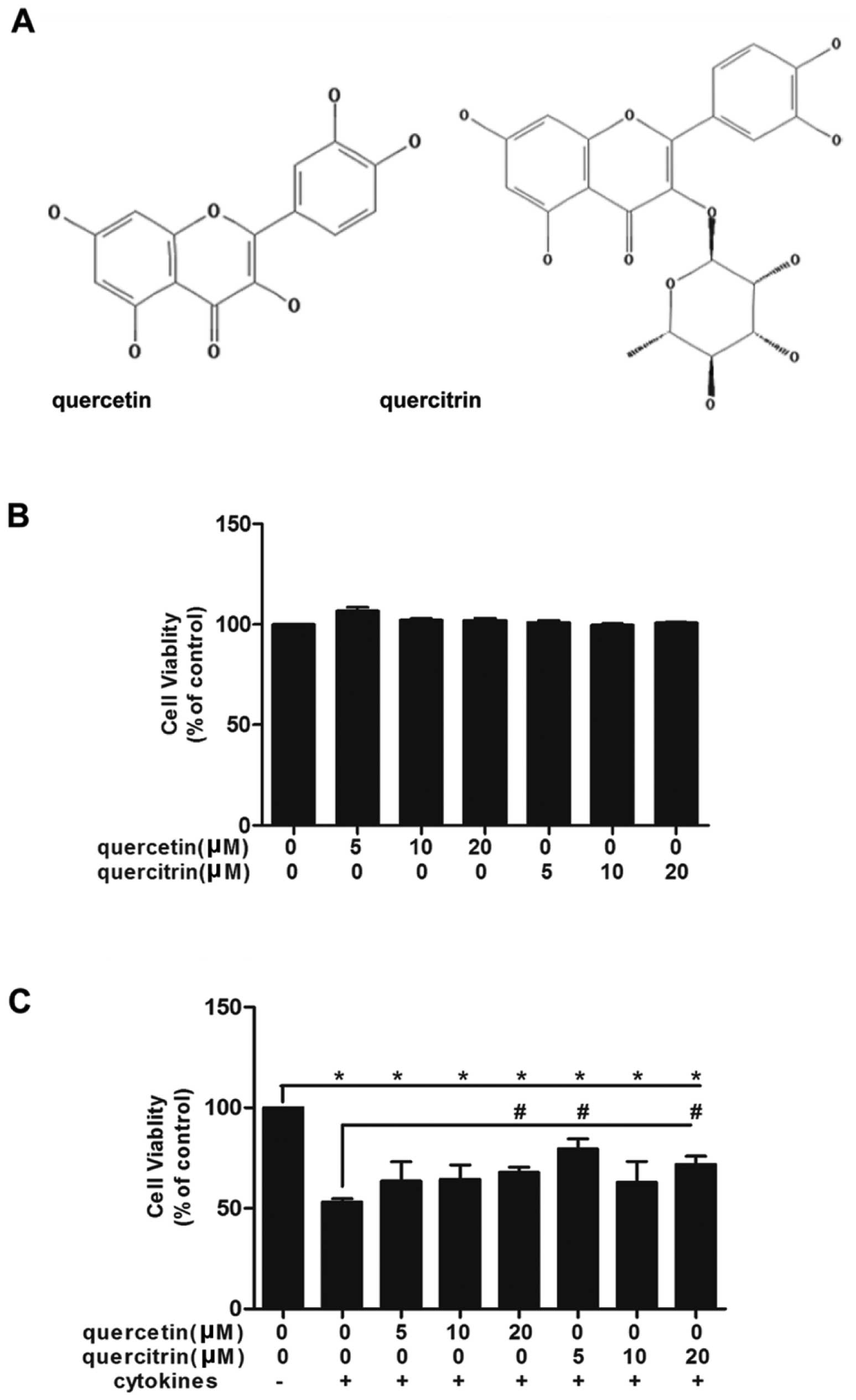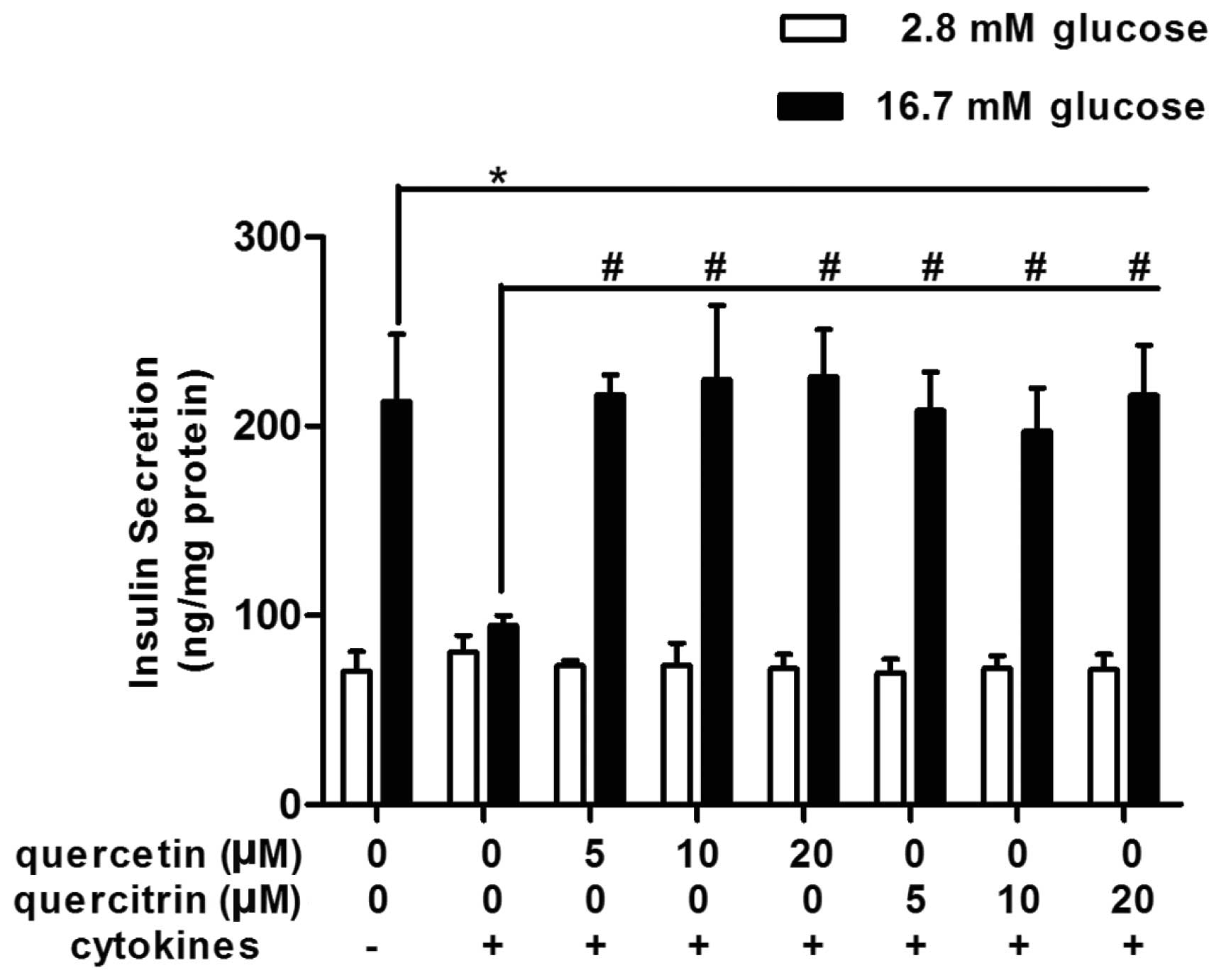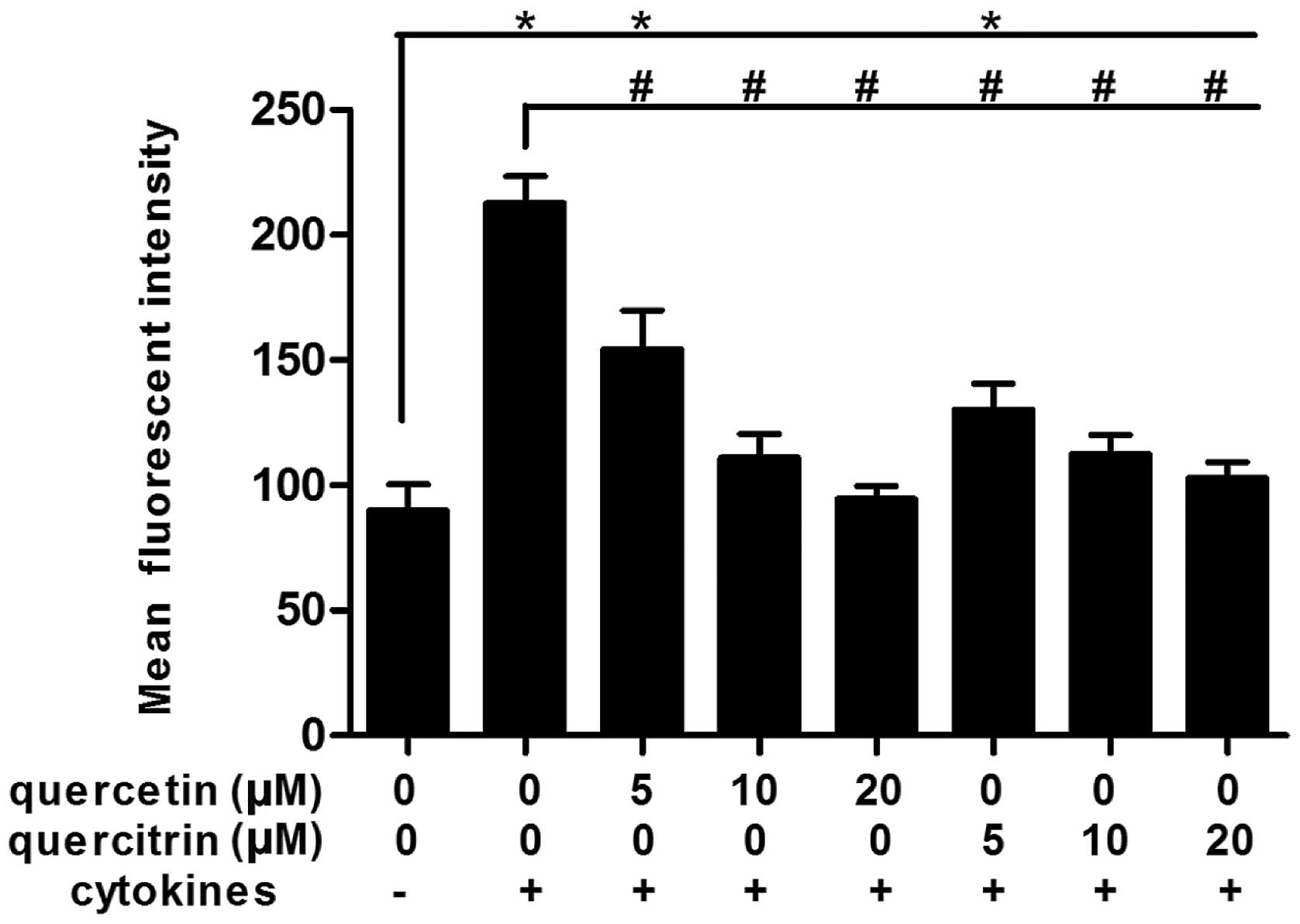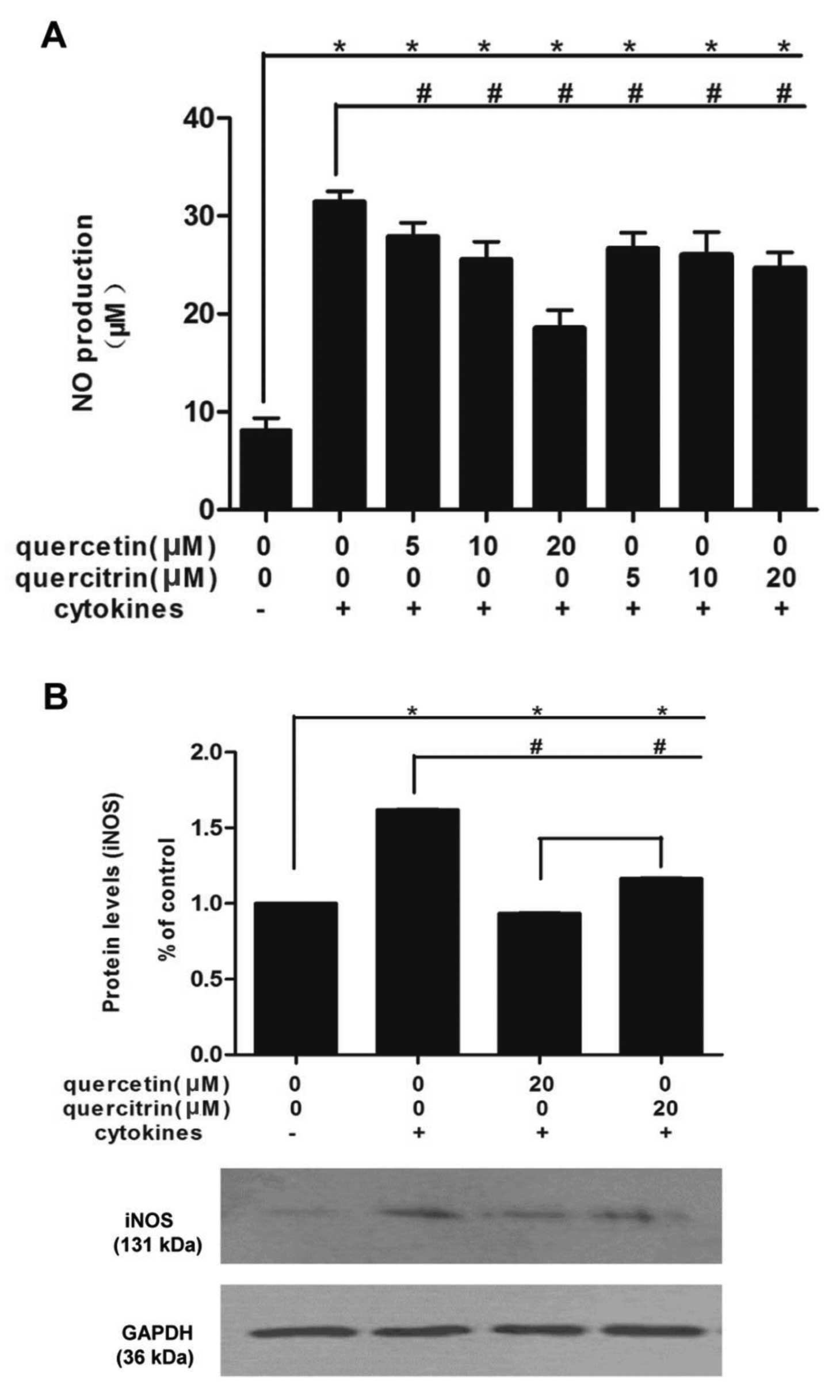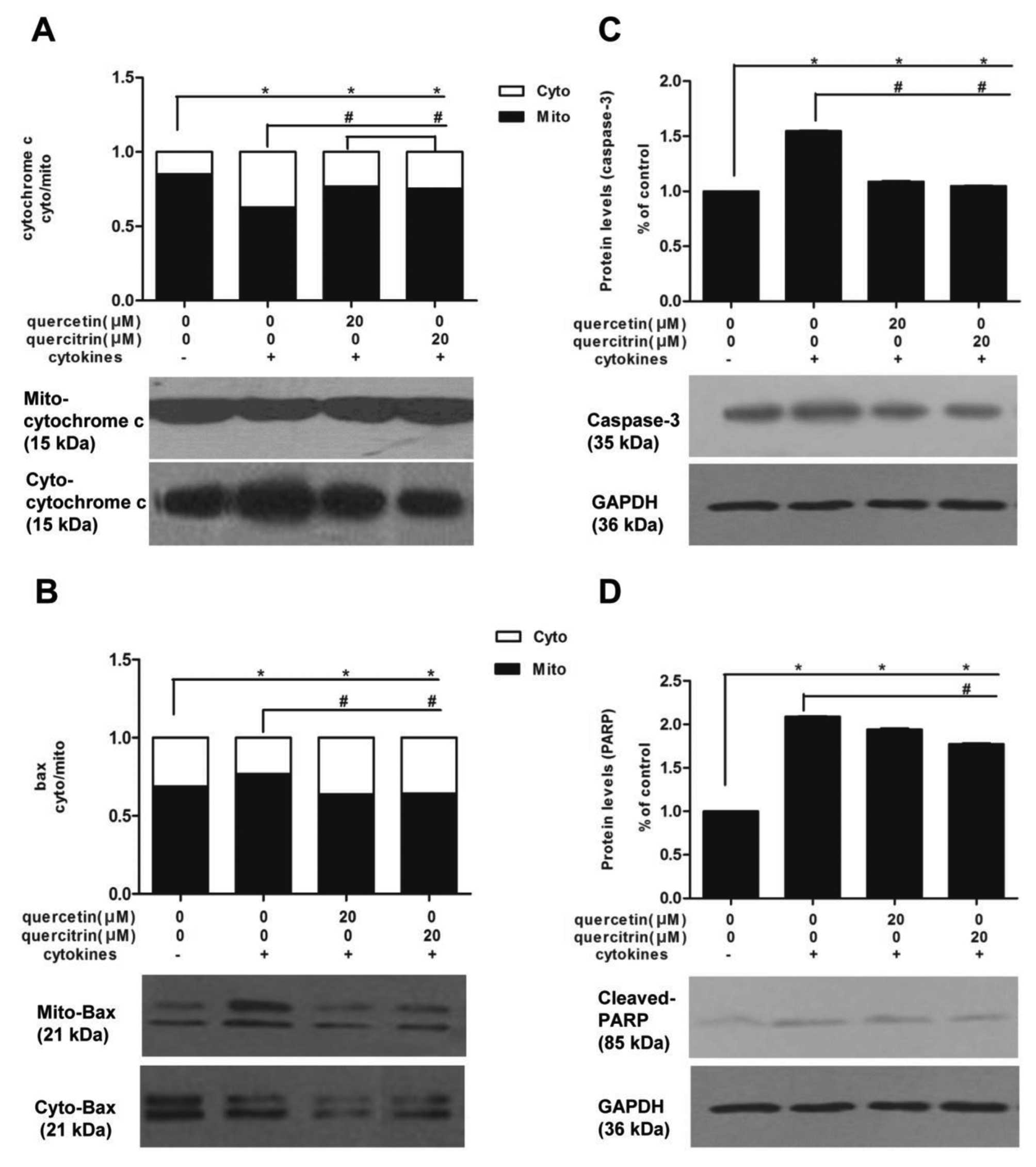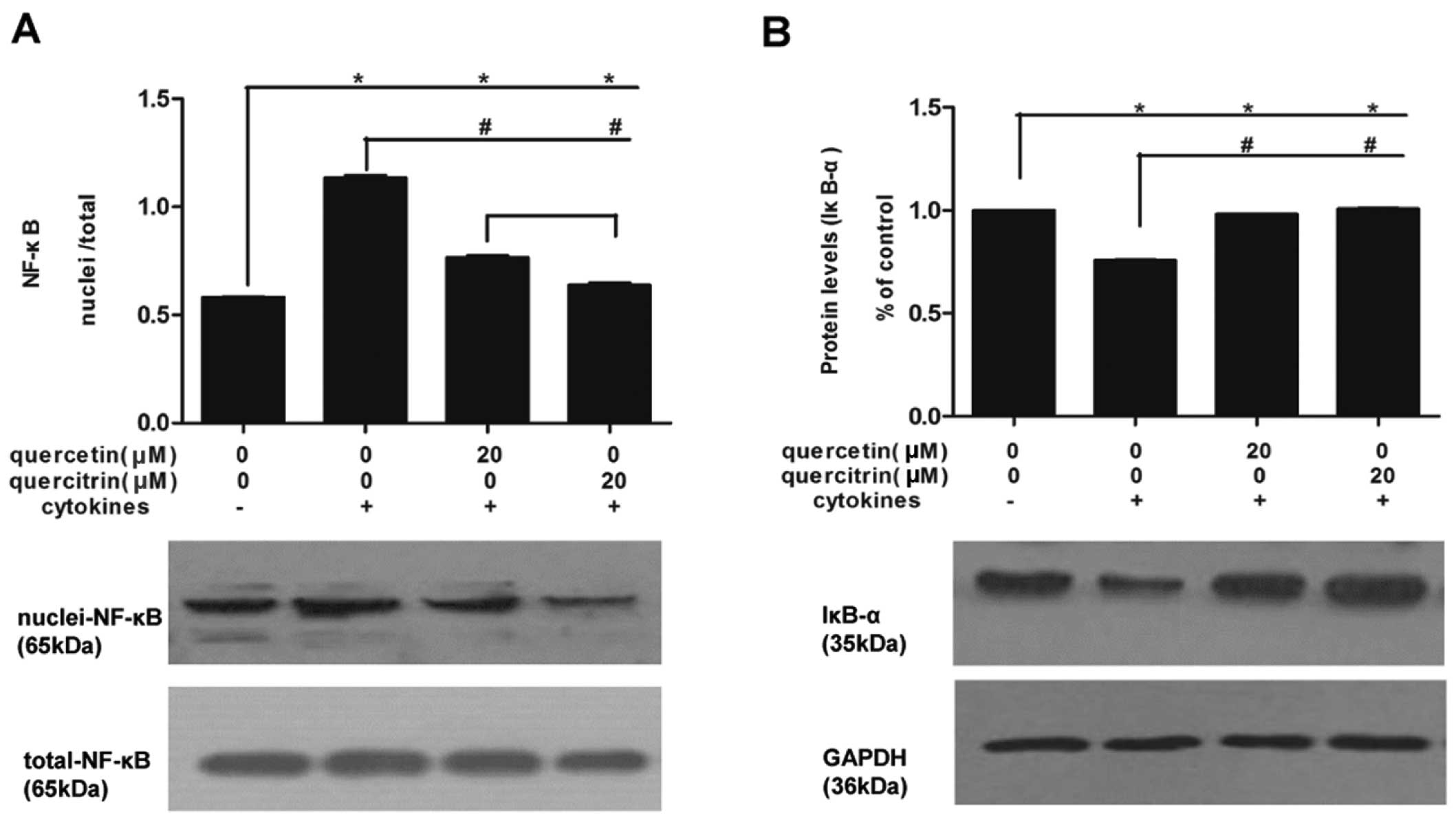Quercetin and quercitrin protect against cytokine‑induced injuries in RINm5F β-cells via the mitochondrial pathway and NF-κB signaling
- Authors:
- Published online on: November 8, 2012 https://doi.org/10.3892/ijmm.2012.1177
- Pages: 265-271
Abstract
Introduction
Phenolic phytochemicals such as flavonoids which are widely found in vegetables, fruits, juices, and tea exert positive health effects in chronic disorders (1). Quercetin (3,5,7,3′,4′-pentahydroxyflavone) is the most common flavonoid in nature, existing primarily in its glycoside form as quercitrin (3-rhamnoside) (2). Several of its bioactivities have been reported, including anti-inflammatory, scavenging oxygen radicals, anticancer, and anti-allergy effects (1,3,4). On account of the wide sources and fewer side-effects compared to drugs, quercetin presents opportunities for the development of novel therapies for diabetes.
β-cell death in type 1 diabetes is mediated by an autoimmune attack with inflammatory process, and the subsequent cytokine release is thought to be responsible for β-cell destruction (5). Cytokine-induced β-cell apoptosis is considered the main form of β-cell death, although necrosis may also occur (6,7). The precise molecular mechanisms that transduce the cytokine signals to evoke destructive gene expression in β-cells remain unclear. However, cytokines may trigger β-cell death via an NF-κB-dependent path resulting in caspase activation and finally causing cell failure (8). Oxidative stress in β-cells reduces the mitochondrial transmembrane potential, promoting the release of cytochrome c into cytosol and activating caspase-3, and this apoptotic process is regulated by the Bcl-2 family (9). Antioxidant chemicals blocking cytokine signaling pathways and protecting β-cells from subsequent cytotoxicity are a promising approach to the treatment of diabetes (10).
Previous studies demonstrated that quercetin was able to protect pancreas β-cells from oxidant damage and promote insulin generation both in vivo and in vitro (11–13). However, the majority of studies focused on the aglycone form (quercetin), while its rhamnose glycoside (quercitrin) attracted little attention due to the lack of commercial standards (14). The comparative results of quercetin and quercitrin remain controversial: Rattanajarasroj and Unchern (16) support that quercitrin may be a more potent antioxidant and neuroprotective agent than its aglycone derivative due to its high bioavailability in the digestive tract (15), while other studies considered quercitrin possessed equal or even weaker antioxidant ability than quercetin (1,17).
Current knowledge of the effects of quercetin/quercitrin on β-cells is mostly limited to the antioxidant ability and the suppression of inflammation. Quercetin protects against β-cell damage as it blocks inflammatory signal molecules in β-cells (12,13). Little is known about the effect of quercetin on cytokine-induced mitochondrial alteration and the downstream signaling that leads to apoptosis. Further research on this potential anti-diabetic component is required. We aimed to investigate the role of quercetin and its glycoside derivative quercitrin in cytokine-induced RINm5F β-cell injuries involving mitochondrial apoptosis and NF-κB signaling. Furthermore, comparison of the differences between quercetin and quercitrin may provide insight into their structures and transportation into cells.
Materials and methods
Chemicals
Quercetin and quercitrin were purchased from Sigma (St. Louis, MO, USA). Tumor necrosis factor-α (TNF-α), interleukin-1β (IL-1β) and interferon-γ (IFN-γ) were obtained from PeproTech, Inc. (Rocky Hill, NJ, USA). Fetal bovine serum (FBS) was purchased from Gibco (Auckland, New Zealand). Cytochrome c, Bax, caspase-3, polyadenosine diphosphate-ribose polymerase (PARP), GAPDH, NF-κB, IκBα, and inducible nitric oxide synthases (iNOS) were obtained from Santa Cruz Biotechnology, Inc. (CA, USA) or Cell Signaling Technology (Beverly, MA, USA). Dichlorodihydrofluorescein diacetate (DCFH-DA) was purchased from Molecular Probes (Eugene, OR, USA). Quercetin and quercitrin were dissolved in dimethyl sulfoxide (DMSO).
Culture and treatment of RINm5F cells
The insulin-secreting cell line RINm5F, donated by Professor C.Y. Zhou (Department of Biochemistry and Molecular Biology, Peking University Health Science Center), was cultured in DMEM with 10% FBS, 100 U/ml penicillin, 100 μg/ml streptomycin, 2 mmol/l in a humidified atmosphere (5% CO2, 37°C). After starvation for 24 h, cells were treated with quercetin or quercitrin (0, 5, 10 and 20 μM) for 2 h, then co-incubated with TNF-α (10 ng/ml), IL-1β (5 ng/ml) and IFN-γ (1,000 U/ml) for 24 h.
Cell viability of RINm5F
The viability of RINm5F was evaluated by the 3-(4,5-dimethylthiazol-2-y1)-2,5-diphenyltetrazolium bromide (MTT) assay. Following incubation for 24 h, cells were washed twice with Krebs-Ringer bicarbonate (KRB) buffer containing 0.1% bovine serum albumin (BSA) and then incubated with the same KRB/BSA supplemented with 100 mg/ml MTT for 4 h in the dark (5% CO2, 37°C). The precipitates in the cells (formazan) were dissolved in 200 μl DMSO, and the absorbance was measured at 570 nm on a microplate reader. The experiments were performed in triplicate.
Glucose-stimulated insulin secretion (GSIS) assay
After a 24-h incubation period, cells were changed to KRB/BSA containing 2.8 mM glucose for 1 h at 37°C, and the supernatant was collected for basal insulin secretion measurement. Next, the medium was replaced with KRB/BSA supplemented with 16.7 mM glucose for 1 h at 37°C, and the supernatant was collected for GSIS measurement. For the detection of insulin we employed radio immunoassay with rat insulin as a standard, and the data were adjusted by the cell protein content of each group.
Nitrite measurement
Following 24 h of cell treatment, the supernatant was collected for nitric oxide (NO) determination using a colorimetric assay. Fifty microliters of culture supernatant were mixed with 50 μl of Griess reagent for 5 min at room temperature, and then the absorbance at 540 nm was measured on a plate reader. Subsequently, the concentrations of nitrite were determined by a linear standard curve from serial dilutions of sodium nitrite.
Reactive oxygen species (ROS) determination
Cellular ROS was measured using 2,7-dichlorodihydrofluorescein diacetate (DCFH-DA) and its oxidation to yield fluorescent dichlorofluorescein could be promoted by ROS in cells. After treatment for 24 h, cells were incubated with 5 μM DCFH-DA for 30 min. Then, the cells were washed twice with KRB, trypsinized, re-suspended and transferred to a flow cytometer for fluorescence intensity detection.
Separation of nuclei and mitochondria extracts from cytoplasm
Mitochondria and cytosol fractions were obtained as previously described (18). Briefly, after 24 h of treatment, RINm5F cells plated on 25 cm2 petri dishes (5×106) were suspended and homogenized. Unbroken cells and nuclei were discarded by centrifugation at 10,000 × g for 20 min at 4°C, while the supernatant was further centrifuged at 10,000 × g for 20 min. The new supernatant was then moved to clean tubes and underwent further centrifugation of 100,000 × g for 1 h at 4°C. The supernatant of 100,000 × g spin was collected as cytosolic fraction, and the pellet of 10,000 × g spin was resuspended in isolation buffer supplemented with 0.5% Nonidet P-40 (NP-40) as mitochondrial fraction.
Nuclear and cytoplasmic proteins were extracted by ProteoJET™ Cytoplasmic and Nuclear Protein Extraction kit (Fermentas International Inc., Canada). In brief, cells were scraped, pelleted by centrifugation at 250 × g for 5 min, mixed with cell lysis buffer, homogenized, and set on ice for 10 min. Then, the mixture was centrifuged at 500 × g for 7 min at 4°C, and then the supernatant was further centrifuged at 20,000 × g for 15 min at 4°C. The supernatant of 20,000 × g spin was collected as cytoplasmic protein extract, and the pellet of 500 × g spin was washed and lysed with reagent of the kit and centrifuged at 20,000 × g for 5 min at 4°C; this final supernatant was collected as nuclei protein extract.
Western blotting
Aside from the mitochondria and nuclei proteins mentioned above, other protein samples were prepared as follows: harvested cells were homogenized in lysis buffer (10 mM Tris, pH 8.0, 120 mM NaCl, 0.5% NP-40, 1 mM EDTA, and protease inhibitors) for 30 min on ice and centrifuged at 10,000 × g at 4°C for 30 min. The supernatants were then collected as samples. Protein content was examined by a BCA protein assay kit (Pierce).
The protein samples from each fraction (40 μg) were mixed with 5× sample loading buffer, and separated via sodium dodecyl sulfate polyacrylamide gel electrophoresis (SDS-PAGE). Proteins were transferred to polyvinylidene fluoride (PVDF) membranes, which were then blocked with 5% skim milk for 1 h at room temperature and incubated at 4°C overnight with primary antibodies. Then, the membranes were incubated with HRP-conjugated second anti-IgG for 2 h and visualized by ECL. The integrated optical density (OPTDI) of each band was normalized with the internal control GAPDH band for comparison.
Statistical analysis
All data are presented as the means ± SEM and compared with one-way ANOVA for differences between groups, and with the Bonferroni-Dunnett T3 procedure for multiple comparisons. Statistical analysis was performed using SPSS 18.0 statistics software, and a value of P<0.05 was considered to indicate statistically significant differences.
Results
Quercetin/quercitrin ameliorate cytokine-impaired viability of RINm5F cells
First, we confirmed the nontoxicity dose of 5, 10 and 20 μM for quercetin/quercitrin (Fig. 1B). Then, we applied these doses to cells whose viabilities were inhibited by cytokines (Fig. 1C). The association of cytokines significantly led to the demise of cells, however, we observed a rise in the viability of cells in the quercetin/quercitrin pretreated groups vs. cytokine treatment alone.
Quercetin/quercitrin improve GSIS in cytokine-treated RINm5F cells
When exposed to a high concentration of glucose (16.7 mM), normal RINm5F cells (untreated control) raised their insulin secretion up to approximately 3-fold, compared with that of the low glucose environment (2.8 mM) (Fig. 2). However, cytokines disturbed this physiological reaction, and glucose-stimulated (16.7 mM) insulin secretion was not better than the basal secretion in the cytokine group (Fig. 2). Quercetin/quercitrin ameliorated cytokine-induced numbness to glucose stimulation in RINm5F cells. Quercetin/quercitrin (5, 10 and 20 μM) treatment resumed cell insulin secretion evoked by high glucose (16.7 mM) (Fig. 2), and the highest dose of both quercetin and quercitrin (20 μM) had the most marked effect on restoring GSIS in RINm5F.
Quercetin/quercitrin reduce production of cellular ROS from cytokines in RINm5F cells
Cytokines rapidly boosted the accumulation of ROS in RINm5F cells (Fig. 3). When RINm5F cells were incubated with cytokines for 24 h, the mean fluorescence intensity (DCFH-DA→DCF) for ROS increased markedly, >2-fold that of the untreated control. However, the mean fluorescence intensity of the quercetin/quercitrin treatment groups decreased significantly compared to the cytokine alone group, rendering a dose-dependent effect.
Quercetin/quercitrin restrain the enhancement of NO production caused by cytokines in RINm5F cells via inhibition of iNOS expression
Combined cytokines rapidly promoted NO production in RINm5F cells (Fig. 4A). NO from cells incubated with cytokines was >3-fold that of untreated cells. However, preincubation of quercetin/quercitrin (5, 10 and 20 μM) for 2 h significantly reduced these boosts, in a dose-dependent manner. Moreover, quercetin (20 μM) had stronger inhibitory effects compared to quercitrin (20 μM).
At the dose of 20 μM, both quercetin and quercitrin showed the most significant effect, so we applied this concentration for the rest of the study. Cytokines markedly increased the cellular expression of iNOS in RINm5F cells, however, quercetin/quercitrin pretreatment (20 μM) reduced iNOS protein levels in cells (Fig. 4B). Also, quercetin showed a greater inhibition of iNOS expression than quercitrin (20 μM).
Quercetin/quercitrin repress apoptosis-associated protein in cytokine-induced RINm5F cells
Since quercetin and quercitrin mitigated the dysfunctional insulin secretion, enhancement of ROS, or abnormal NO production in RINm5F cells induced by cytokines, we investigated the underlying mechanisms.
First, we investigated cytochrome c and Bax protein expressions in subcellular fraction. Cytokines promoted cytochrome c to translocate from mitochondria to cytoplasm in RINm5F cells, and the fraction of band density (mitochondria to cytoplasm) were significantly decreased compared to untreated cells. However, we observed a moderate rise of fraction (mitochondria to cytoplasm) in cells pretreated with quercetin or quercitrin, compared to the cytokine alone group (Fig. 5A). Also, cytokines caused an enrichment of Bax in mitochondira in RINm5F cells, however, this enrichment was inhibited by a 2-h preincubation of quercetin or quercitrin (20 μM) to a certain extent (Fig. 5B). We also examined cellular levels of caspase-3 and cleaved PARP. Caspase-3 (Fig. 5C) and cleaved PARP (Fig. 5D) levels of the cytokine group were higher than in the untreated control, yet the addition of quercetin or quercitrin (20 μM) reduced their expression.
We also measured NF-κB (Fig. 6A) and IκBα (Fig. 6B) expression in nuclei and cellular levels. Cytokines promoted NF-κB assembled in the nucleus of RINm5F cells, which was relieved by quercetin or quercitrin, and quercetin had a greater inhibitory effect compared to quercitrin. At the same time, total protein expression of IκBα moderately decreased in the cytokine group compared to that in the untreated group, while this decline was limited in the group with either quercetin or quercitrin pretreatment.
Discussion
In the present study, we found that quercetin/quercitrin improved the cytokine-induced impairment of viability and insulin secretion in RINm5F cells. We propose that quercetin/quercitrin protect β-cells by mediating ROS accumulation, iNOS expression, NF-κB pathway and mitochondria cytochrome c signaling.
Tumor necrosis factor-α (TNF-α), interleukin-1β (IL-1β), and interferon-γ (IFN-γ) have a direct influence on β-cell destruction, possibly due to apoptosis, necrosis or other processes (19,20). Here, we found that the combined cytokines significantly decreased both the viability and glucose-stimulated insulin secretion (GSIS) in RINm5F β-cells, and this toxicity existed with an intensified oxidative stress. Oxidative stress was considered a causal link between inflammation and cell death (21–23), and it could activate caspases, induce polyadenosine diphosphate-ribose polymerase (PARP) cleavage and cell death (24). Thus, exploring relevant nutritional substances benefitting cellular redox maintenance such as quercetin may shed light on possible treatment of β-cell failure. Quercetin is the most ubiquitous antioxidative flavonoid in nature, and it is usually presented in its glycosylated form, quercitrin (2). Quercetin and quercitrin have been found to have protective effects on β-cells, although findings remain limited and controversial. Our results demonstrated that quercetin was able to maintain impaired β-cell viability and GSIS, which had linkages with inhibited accumulation of ROS.
Accumulating evidence shows that the mitochondrial intrinsic pathway of apoptosis plays a major role in pancreatic β-cell death in diabetes (23,25). We found that a combination of TNF-α, IL-1β and IFN-γ promoted mitochondrial apoptosis, which is consistent with previous studies that these combined cytokines induce mitochondrial membrane depolarization and cytochrome c release in the RINm5F β-cell line (26,27). Notably, quercetin/quercitrin suppressed cytokine-induced translocation of the pro-apoptotic Bcl-2 family protein (Bax), cytochrome c release and caspase-3 alteration, thereby indicating its role as an anti-apoptotic agent in cytokine-induced β-cell suffering. Cytochrome c promoted by the pro-apoptotic proteins releases from mitochondrial, and these upstream alteration inspire the downstream caspase-3 cleavage, which is an essential signal of mitochondrial events of apoptosis (28). Our study also indicated that an increased caspase-3 expression was concomitant with the altered metabolism of PARP, which is consistent with a previous report on caspase-3 involvement in PARP cleavage and cell death (29). In the damaged pancreatic β-cells, PARP activates via cleavage and repairs the damaged DNA with nicotinamide adenine dinucleotide + (NAD+) (30). When cleaved PARP is exhausted, cells are destroyed by apoptosis (30). Quercetin/quercitrin protected β-cells via inhibition of mitochondrial apoptosis and the prevention of PARP activation. However, the direct cause-effect relationship between apoptosis and cleavage was not verified in this study, and requires further elucidation.
Cytokines were also able to induce nitric oxide (NO) formation, which is generated by inducible nitric oxide synthase (iNOS) (31). Our results indicated that NO/iNOS production was involved in the protection of the toxicity to RINm5F cells of quercetin/quercitrin. The iNOS gene was also found to play a role in the neuroprotective effect of quercetin (32), therefore we hypothesized that the NO/iNOS system was an important part of the mechanism of quercetin. The relationship between the iNOS pathway and mitochondrial apoptosis was not fully confirmed, however, a previous study reported that NO could lead to mitochondrial membrane potential changes and the following release of cytochrome c triggers apoptosis (33).
The transcription factor NF-κB is one of the key mediators of cytokine-induced β-cell death, and it has been reported to regulate expression of iNOS (8,34). When stimulated by inducers, presumably via phosphorylation of IκBα, NF-κB dimers release from initially inactive complex in the cytoplasm and translocate into the nucleus and promote the transcription of target genes (34,35). Thus, we assumed that NF-κB activation, a crucial mediator of iNOS gene expression, could be an upstream target for the inhibitory effects of quercetin/quercitrin. Our results demonstrated that degradation of IκBα and the translocation of NF-κB subunit p65 to nuclei induced by cytokines were remarkably attenuated when RINm5F cells were pretreated by quercetin/quercitrin. This is consistent with the effect of quercetin on NF-κB signal transduction in osteoclast precursors (36). This finding provides insight into the mechanism underlying the protective effects of quercetin/quercitrin against cytokine-impaired β-cells. However, we did not verify that the NF-κB activation directly induced iNOS expression.
In this study, we investigated the aglycone and rhamnose glucoside form of quercetin. As a glycosylated form of quercetin, quercitrin contains a rhamnose at C3 (Fig. 1A). Due to its additional radical and high bioavailability in the digestive tract, quercitrin was considered to be a more potent antioxidant and neuroprotective agent compared to quercetin (15,16,37). However, the results of our study were not in accordance with this. On the contrary, quercetin possessed even stronger protective effects on RINm5F β-cells. This was consistent with previous studies, such as the one by Wagner et al (1), who found that quercetin afforded more protective effects on MeHg-induced lipid peroxidation and ROS generation in mitochondria and brain slices, as well as the study of Chow et al (17), who reported that quercetin rather than quercitrin protected RAW264.7 macrophages from oxidative stress-induced apoptosis and mitochondrial dysfunction. We hypothesized that the sugar moiety of the glycosides inhibited the lipophilicity of quercetin or their effect relied on different pathways or cell types; however, this requires further investigations.
In conclusion, we evaluated the anti-diabetic and protective effects of quercetin/quercitrin and identified the underlying mechanisms of cytokine-induced RINm5F pancreatic β-cells. The interaction of the underlying mechanisms remains to be confirmed in future studies. In addition, quercetin may be more efficacious than quercitrin as an anti-diabetic agent.
Acknowledgements
This study was part of a project sponsored by the National Natural Science Foundation of China (NSFC) with code H2603/81172652.
References
|
Wagner C, Vargas AP, Roos DH, et al: Comparative study of quercetin and its two glycoside derivatives quercitrin and rutin against methylmercury (MeHg)-induced ROS production in rat brain slices. Arch Toxicol. 84:89–97. 2010. View Article : Google Scholar : PubMed/NCBI | |
|
Hertog MG, Feskens EJ, Hollman PC, Katan MB and Kromhout D: Dietary antioxidant flavonoids and risk of coronary heart disease: the Zutphen Elderly Study. Lancet. 342:1007–1011. 1993. View Article : Google Scholar : PubMed/NCBI | |
|
Babujanarthanam R, Kavitha P, Mahadeva Rao US and Pandian MR: Quercitrin a bioflavonoid improves the antioxidant status in streptozotocin: induced diabetic rat tissues. Mol Cell Biochem. 358:121–129. 2011. View Article : Google Scholar : PubMed/NCBI | |
|
Coskun O, Kanter M, Korkmaz A and Oter S: Quercetin, a flavonoid antioxidant, prevents and protects streptozotocin-induced oxidative stress and beta-cell damage in rat pancreas. Pharmacol Res. 51:117–123. 2005. View Article : Google Scholar : PubMed/NCBI | |
|
Mathis D, Vence L and Benoist C: beta-Cell death during progression to diabetes. Nature. 414:792–798. 2001. View Article : Google Scholar : PubMed/NCBI | |
|
Mandrup-Poulsen T: Apoptotic signal transduction pathways in diabetes. Biochem Pharmacol. 66:1433–1440. 2003. View Article : Google Scholar : PubMed/NCBI | |
|
Saldeen J: Cytokines induce both necrosis and apoptosis via a common Bcl-2-inhibitable pathway in rat insulin-producing cells. Endocrinology. 141:2003–2010. 2000.PubMed/NCBI | |
|
Cnop M, Welsh N, Jonas JC, Jorns A, Lenzen S and Eizirik DL: Mechanisms of pancreatic beta-cell death in type 1 and type 2 diabetes: many differences, few similarities. Diabetes. 54(Suppl 2): S97–S107. 2005. View Article : Google Scholar : PubMed/NCBI | |
|
Tsujimoto Y: Cell death regulation by the Bcl-2 protein family in the mitochondria. J Cell Physiol. 195:158–167. 2003. View Article : Google Scholar : PubMed/NCBI | |
|
Menegazzi M, Novelli M, Beffy P, et al: Protective effects of St. John’s wort extract and its component hyperforin against cytokine-induced cytotoxicity in a pancreatic beta-cell line. Int J Biochem Cell Biol. 40:1509–1521. 2008. | |
|
Adewole SO, Caxton-Martins EA and Ojewole JA: Protective effect of quercetin on the morphology of pancreatic beta-cells of streptozotocin-treated diabetic rats. Afr J Tradit Complement Altern Med. 4:64–74. 2006.PubMed/NCBI | |
|
Youl E, Bardy G, Magous R, et al: Quercetin potentiates insulin secretion and protects INS-1 pancreatic beta-cells against oxidative damage via the ERK1/2 pathway. Br J Pharmacol. 161:799–814. 2010. View Article : Google Scholar : PubMed/NCBI | |
|
Cho JM, Chang SY, Kim DB, Needs PW, Jo YH and Kim MJ: Effects of physiological quercetin metabolites on interleukin-1beta-induced inducible NOS expression. J Nutr Biochem. Jan 3–2012.(Epub ahead of print). | |
|
Babujanarthanam R, Kavitha P and Pandian MR: Quercitrin, a bioflavonoid improves glucose homeostasis in streptozotocin-induced diabetic tissues by altering glycolytic and gluconeogenic enzymes. Fundam Clin Pharmacol. 24:357–364. 2010. View Article : Google Scholar | |
|
Hollman PC, de Vries JH, van Leeuwen SD, Mengelers MJ and Katan MB: Absorption of dietary quercetin glycosides and quercetin in healthy ileostomy volunteers. Am J Clin Nutr. 62:1276–1282. 1995.PubMed/NCBI | |
|
Rattanajarasroj S and Unchern S: Comparable attenuation of Abeta(25–35)-induced neurotoxicity by quercitrin and 17beta-estradiol in cultured rat hippocampal neurons. Neurochem Res. 35:1196–1205. 2010.PubMed/NCBI | |
|
Chow JM, Shen SC, Huan SK, Lin HY and Chen YC: Quercetin, but not rutin and quercitrin, prevention of H2O2-induced apoptosis via anti-oxidant activity and heme oxygenase 1 gene expression in macrophages. Biochem Pharmacol. 69:1839–1851. 2005.PubMed/NCBI | |
|
Cai L, Li W, Wang G, Guo L, Jiang Y and Kang YJ: Hyperglycemia-induced apoptosis in mouse myocardium: mitochondrial cytochrome C-mediated caspase-3 activation pathway. Diabetes. 51:1938–1948. 2002. View Article : Google Scholar : PubMed/NCBI | |
|
Veluthakal R, Jangati GR and Kowluru A: IL-1beta-induced iNOS expression, NO release and loss in metabolic cell viability are resistant to inhibitors of ceramide synthase and sphingomyelinase in INS 832/13 cells. JOP. 7:593–601. 2006.PubMed/NCBI | |
|
Denis MC, Mahmood U, Benoist C, Mathis D and Weissleder R: Imaging inflammation of the pancreatic islets in type 1 diabetes. Proc Natl Acad Sci USA. 101:12634–12639. 2004. View Article : Google Scholar : PubMed/NCBI | |
|
Michalska M, Wolf G, Walther R and Newsholme P: Effects of pharmacological inhibition of NADPH oxidase or iNOS on pro-inflammatory cytokine, palmitic acid or H2O2-induced mouse islet or clonal pancreatic beta-cell dysfunction. Biosci Rep. 30:445–453. 2010. View Article : Google Scholar : PubMed/NCBI | |
|
Pi J, Bai Y, Zhang Q, et al: Reactive oxygen species as a signal in glucose-stimulated insulin secretion. Diabetes. 56:1783–1791. 2007. View Article : Google Scholar : PubMed/NCBI | |
|
Cumaoglu A, Ari N, Kartal M and Karasu C: Polyphenolic extracts from Olea europea L. protect against cytokine-induced beta-cell damage through maintenance of redox homeostasis. Rejuvenation Res. 14:325–334. 2011. | |
|
Burkle A: Physiology and pathophysiology of poly(ADP-ribosyl)ation. Bioessays. 23:795–806. 2001. View Article : Google Scholar : PubMed/NCBI | |
|
Allagnat F, Cunha D, Moore F, Vanderwinden JM, Eizirik DL and Cardozo AK: Mcl-1 downregulation by pro-inflammatory cytokines and palmitate is an early event contributing to beta-cell apoptosis. Cell Death Differ. 18:328–337. 2011. View Article : Google Scholar : PubMed/NCBI | |
|
Barbu A, Welsh N and Saldeen J: Cytokine-induced apoptosis and necrosis are preceded by disruption of the mitochondrial membrane potential (Deltapsi(m)) in pancreatic RINm5F cells: prevention by Bcl-2. Mol Cell Endocrinol. 190:75–82. 2002. View Article : Google Scholar | |
|
Mehmeti I, Lenzen S and Lortz S: Modulation of Bcl-2-related protein expression in pancreatic beta cells by pro-inflammatory cytokines and its dependence on the antioxidative defense status. Mol Cell Endocrinol. 332:88–96. 2011. View Article : Google Scholar : PubMed/NCBI | |
|
Lakhani SA, Masud A, Kuida K, et al: Caspases 3 and 7: key mediators of mitochondrial events of apoptosis. Science. 311:847–851. 2006. View Article : Google Scholar : PubMed/NCBI | |
|
Muranyi M, Fujioka M, He Q, et al: Diabetes activates cell death pathway after transient focal cerebral ischemia. Diabetes. 52:481–486. 2003. View Article : Google Scholar : PubMed/NCBI | |
|
Virag L, Marmer DJ and Szabo C: Crucial role of apopain in the peroxynitrite-induced apoptotic DNA fragmentation. Free Radic Biol Med. 25:1075–1082. 1998. View Article : Google Scholar : PubMed/NCBI | |
|
Roeske-Nielsen A, Dalgaard LT, Mansson JE and Buschard K: The glycolipid sulfatide protects insulin-producing cells against cytokine-induced apoptosis, a possible role in diabetes. Diabetes Metab Res Rev. 26:631–638. 2010. View Article : Google Scholar : PubMed/NCBI | |
|
Zhang ZJ, Cheang LC, Wang MW and Lee SM: Quercetin exerts a neuroprotective effect through inhibition of the iNOS/NO system and pro-inflammation gene expression in PC12 cells and in zebrafish. Int J Mol Med. 27:195–203. 2011.PubMed/NCBI | |
|
Hirst DG and Robson T: Nitrosative stress as a mediator of apoptosis: implications for cancer therapy. Curr Pharm Des. 16:45–55. 2010. View Article : Google Scholar : PubMed/NCBI | |
|
Melloul D: Role of NF-kappaB in beta-cell death. Biochem Soc Trans. 36:334–339. 2008. View Article : Google Scholar : PubMed/NCBI | |
|
Ghosh S and Karin M: Missing pieces in the NF-kappaB puzzle. Cell. 109(Suppl): S81–S96. 2002. View Article : Google Scholar : PubMed/NCBI | |
|
Yamaguchi M and Weitzmann MN: Quercetin, a potent suppressor of NF-κB and Smad activation in osteoblasts. Int J Mol Med. 28:521–525. 2011.PubMed/NCBI | |
|
Morand C, Manach C, Crespy V and Remesy C: Quercetin 3-O-beta-glucoside is better absorbed than other quercetin forms and is not present in rat plasma. Free Radic Res. 33:667–676. 2000. View Article : Google Scholar : PubMed/NCBI |



